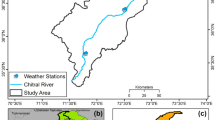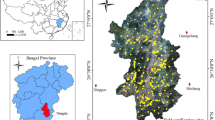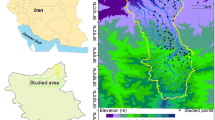Abstract
Purpose
Hilly areas are highly susceptible to soil erosion. This study aims to discover the drivers of soil erosion, identify soil erosion–sensitive areas, and predict future soil erosion in typical hilly areas of Hubei Province, China, using combined RUSLE and LSTM models.
Materials and methods
In this study, soil erosion in hilly areas of Hubei Province from 2000 to 2020 was quantitatively analyzed using the revised universal soil loss equation (RUSLE), and the soil erosion sensitivity evaluation system was constructed, a geographic detector was employed to identify the main drivers of soil erosion sensitivity, and using the long short-term memory neural network model (LSTM) to predict soil erosion in 2025.
Results and discussions
The results showed that most areas were dominated by slight and moderate erosion. Slope and vegetation coverage were identified as the core elements influencing the space heterogeneity of soil erosion. Soil erosion sensitivity was mainly composed of moderate sensitivity, accounting for more than 70% of the total area. The strong and extreme sensitivity demonstrated a downward trend with the continued implementation of slope management and forest rehabilitation from slope agriculture, whereas the sensitivity was still higher in the northwest and southwest Hubei Province. Regions with severe soil erosion had high sensitivity, and the spatial distribution of the two is strongly coherent. Areas with surface relief > 300 m and vegetation cover < 30% had the highest sensitivity and should be highly valued. The percentage of moderate and higher soil erosion area in 2025 was 3.77% lower than in 2020, but severe erosion still exists in the northwest and southwest Hubei Province.
Conclusions
Soil erosion sensitivity in the western part of the study area was the highest, followed by the southeast, and the overall erosion sensitivity was gradually decreasing during the studied period. In the future, soil erosion intensity will show a downward trend, whereas the deployment of soil and water conservation measures in soil erosion–sensitive areas should still be strengthened. The results are helpful for accurate soil erosion control and prediction in the hilly areas of Hubei Province, China.
Graphical Abstract









Similar content being viewed by others
Data availability
The data that support the findings of this study are available on request from the corresponding author.
References
Bag R, Mondal I, Dehbozorgi M, Bank SP, Das DN, Bandyopadhyay J, Pham QB, Fadhil Al-Quraishi AM, Nguyen XC (2022) Modelling and mapping of soil erosion susceptibility using machine learning in a tropical hot sub-humid environment. J Clean Prod 364:132428
Belayneh M (2023) Factors affecting the adoption and effectiveness of soil and water conservation measures among small-holder rural farmers: the case of Gumara watershed. RCR Advances 18:200159
Biddoccu M, Guzmán G, Capello G, Thielke T, Strauss P, Winter S, Zaller JG, Nicolai A, Cluzeau D, Popescu D, Bunea C, Hoble A, Cavallo E, Gómez JA (2020) Evaluation of soil erosion risk and identification of soil cover and management factor (C) for RUSLE in European vineyards with different soil management. Int Soil Water Conserv Res 8:337–353
Cao Y, Hua L, Tang Q, Liu L, Cai C (2023) Evaluation of monthly-scale soil erosion spatio-temporal dynamics and identification of their driving factors in Northeast China. Ecol Indic 150:110187
Chen H-S, Wang X-K, Lei S, Wang X-X, Yan X-F (2023) Soil erosion characteristics in an earthquake-impacted mountainous basin based on RUSLE model: implications for geohazards. J Soils Sediments. https://doi.org/10.1007/s11368-023-03586-9
Chen J, Xiao H, Li Z, Liu C, Ning K, Tang C (2020) How effective are soil and water conservation measures (SWCMs) in reducing soil and water losses in the red soil hilly region of China? A meta-analysis of field plot data. Sci Total Environ 735:139517
Chen L, Guo Z, Yin K, Shrestha DP, Jin S (2019a) The influence of land use and land cover change on landslide susceptibility: a case study in Zhushan Town, Xuan’en County (Hubei, China). Nat Hazards Earth Syst Sci 19:2207–2228
Chen S, Zha X, Bai Y, Wang L (2019b) Evaluation of soil erosion vulnerability on the basis of exposure, sensitivity, and adaptive capacity: a case study in the Zhuxi watershed, Changting, Fujian Province, Southern China. CATENA 177:57–69
Chuenchum P, Xu M, Tang W (2020) Estimation of soil erosion and sediment yield in the lancang–mekong river using the modified revised universal soil loss equation and GIS techniques. Water 12(1):135
Cunha ERD, Santos CAG, Silva RMD, Panachuki E, Oliveira PTS, Oliveira NS, Falcao KDS (2022) Assessment of current and future land use/cover changes in soil erosion in the Rio da Prata basin (Brazil). Sci Total Environ 818:151811
Dash SS, Maity R (2023) Effect of climate change on soil erosion indicates a dominance of rainfall over LULC changes. J Hydrol-Reg Stud 47:101373
Deng L, Kim D-G, Li M, Huang C, Liu Q, Cheng M, Shangguan Z, Peng C (2019) Land-use changes driven by “Grain for Green” program reduced carbon loss induced by soil erosion on the Loess Plateau of China. Global Planet Change 177:101–115
Endalie D, Haile G, Taye W (2022) Deep learning model for daily rainfall prediction: case study of Jimma, Ethiopia. Water Supply 22:3448–3461
Fang F, Fang Q, Yu W, Fan C, Zi R, Zhao L (2022) RUSLE Model evaluation of the soil and water conservation ratio of the guizhou province in China between 2000 and 2019. Sustainability 14(13):8219
Fang H-J, Yang X-M, Zhang X-P, Liang A-Z (2006) Using 137 Cs tracer technique to evaluate erosion and deposition of black soil in Northeast China. Pedosphere 16:201–209
Fang L, Wang L, Chen W, Sun J, Cao Q, Wang S, Wang L (2021) Identifying the impacts of natural and human factors on ecosystem service in the Yangtze and Yellow River basins. J Clean Prod 314:127995
Fernandez C, Vega JA (2018) Evaluation of the rusle and disturbed wepp erosion models for predicting soil loss in the first year after wildfire in NW Spain. Environ Res 165:279–285
Fu SH, Liu BY, Zhou GY, Sun ZX, Zhu XL (2015) Calculation tool of topographic factors. Sci Soil Water Conserv 05:105–110
Ghorbanzadeh O, Meena SR, Blaschke T, Aryal J (2019) UAV-based slope failure detection using deep-learning convolutional neural networks. Remote Sens 11:2046
Guo Y, Du X, Li D, Zheng G, Zhang X, Chen H, Zheng J (2022) How newly developed shale gas facilities influence soil erosion in a karst region in SW China. Sci Total Environ 818:151825
Guo Y, Peng C, Zhu Q, Wang M, Wang H, Peng S, He H (2019) Modelling the impacts of climate and land use changes on soil water erosion: model applications, limitations and future challenges. J Environ Manage 250:109403
Hembram TK, Saha S (2018) Prioritization of sub-watersheds for soil erosion based on morphometric attributes using fuzzy AHP and compound factor in Jainti River basin, Jharkhand, Eastern India. Environ Dev Sustain 22:1241–1268
Hessel R, Daroussin J, Verzandvoort S, Walvoort D (2014) Evaluation of two different soil databases to assess soil erosion sensitivity with MESALES for three areas in Europe and Morocco. CATENA 118:234–247
Huang B, Zha R, Chen S, Zha X, Jiang X (2023) Fuzzy evaluation of ecological vulnerability based on the SRP-SES method and analysis of multiple decision-making attitudes based on OWA operators: a case of Fujian Province, China. Ecol Indic 153:110432
Huo A, Peng J, Cheng Y, Luo P, Zhao Z, Zheng C (2020) Hydrological analysis of Loess Plateau highland control schemes in Dongzhi Plateau. Front Earth Sc-Switz 8:528632
Jin F, Yang W, Fu J, Li Z (2021) Effects of vegetation and climate on the changes of soil erosion in the Loess Plateau of China. Sci Total Environ 773:145514
Khosravi K, Rezaie F, Cooper JR, Kalantari Z, Abolfathi S, Hatamiafkoueieh J (2023) Soil water erosion susceptibility assessment using deep learning algorithms. J Hydrol 618:129229
Kratzert F, Klotz D, Brenner C, Schulz K, Herrnegger M (2018) Rainfall–runoff modelling using long short-term memory (LSTM) networks. Hydrol Earth Syst Sci 22:6005–6022
Li H, Guan Q, Sun Y, Wang Q, Liang L, Ma Y, Du Q (2022a) Spatiotemporal analysis of the quantitative attribution of soil water erosion in the upper reaches of the Yellow River Basin based on the RUSLE-TLSD model. CATENA 212:106081
Li J, Bai Y, Alatalo JM (2020) Impacts of rural tourism-driven land use change on ecosystems services provision in Erhai Lake Basin, China. Ecosyst Serv 42:101081
Li J, Chen J, Hua L, Han Z, Cai C (2022b) Spatial and temporal characteristics of soil erosion in Hubei Province based on CSLE. J Soil Water Conserv 36:43–52+62
Li J, He H, Zeng Q, Chen L, Sun R (2023) A Chinese soil conservation dataset preventing soil water erosion from 1992 to 2019. Sci Data 10:319
Liang S, Fang H (2020) Quantitative analysis of driving factors in soil erosion using geographic detectors in Qiantang River catchment, Southeast China. J Soils Sediments 21:134–147
Liu C, Jia X, Ren L, Zhao C, Yao Y, Zhang Y, Ma S (2023a) Cropland-to-shrubland conversion reduces soil water storage and contributes little to soil carbon sequestration in a dryland area. Agric Ecosyst Environ 354:108572
Liu X, Bao Y, Wang Y, Zhang D, Hu M, Wu X, Wen J, Li S, Sun M (2023b) Spatiotemporal variation characteristics of sediment nutrient load from the soil erosion of the Yangtze River Basin of China from 1901 to 2010. Ecol Indic 150:110206
Lu R, Dai E, Wu C (2023) Spatial and temporal evolution characteristics and driving factors of soil conservation services on the Qinghai-Tibet Plateau. CATENA 221:106766
Luo Q, Zhou J, Li Z, Yu B (2020) Spatial differences of ecosystem services and their driving factors: a comparation analysis among three urban agglomerations in China’s Yangtze River economic belt. Sci Total Environ 725:138452
Luo Z, Chen X, Li N, Li J, Zhang W, Wang TJJ (2023) Spatiotemporal foresting of soil erosion for SSP-RCP scenarios considering local vegetation restoration project: a case study in the three gorges reservoir (TGR) area. China J Environ Manage 337:117717
Ma X, Li Y, Li B, Han W, Liu D, Gan X (2016) Nitrogen and phosphorus losses by runoff erosion: field data monitored under natural rainfall in Three Gorges Reservoir area, China. CATENA 147:797–808
Mirzaee S, Ghorbani-Dashtaki S, Kerry R (2020) Comparison of a spatial, spatial and hybrid methods for predicting inter-rill and rill soil sensitivity to erosion at the field scale. CATENA 188:104439
Mohammed S, Jouhra A, Enaruvbe GO, Bashir B, Barakat M, Alsilibe F, Cimusa Kulimushi L, Alsalman A, Szabó S (2023) Performance evaluation of machine learning algorithms to assess soil erosion in Mediterranean farmland: a case-study in Syria. Land Degrad Dev 34:2896–2911
Pan J, Wang J, Gao F, Liu GJGI (2022) Quantitative estimation and influencing factors of ecosystem soil conservation in Shangri-La, China. Geocarto Int 02:14828–14842
Pidoto R, Bezak N, Müller-Thomy H, Shehu B, Callau-Beyer AC, Zabret K, Haberlandt U (2022) Comparison of rainfall generators with regionalisation for the estimation of rainfall erosivity at ungauged sites. Earth Surf Dynam 10:851–863
Polykretis C, Alexakis DD, Grillakis MG, Manoudakis S (2020) Assessment of intra-annual and inter-annual variabilities of soil erosion in Crete island (Greece) by incorporating the dynamic “nature” of R and C-factors in RUSLE modeling. Remote Sens 12(15):2439
Rajbanshi J, Das S, Paul R (2023) Quantification of the effects of conservation practices on surface runoff and soil erosion in croplands and their trade-off: a meta-analysis. Sci Total Environ 864:161015
Rashid I, Aneaus S, Dar SA, Javed O, Khanday SA, Bhat SU (2023) A novel GIS-based multicriteria analysis approach for ascertaining the catchment-scale degradation of a Himalayan wetland. Environ Res 229:115967–115967
Renard KG, Foster GR, Weesies GA (1997) Predicting soil erosion by water: a guide to conservation planning with the revised universal soil loss equation (RUSLE). Washington, DC
Schmaltz EM, Krammer C, Dersch G, Weinberger C, Kuderna M, Strauss P (2023) The effectiveness of soil erosion measures for cropland in the Austrian Agri-environmental Programme: a national approach using local data. Agric Ecosyst Environ 355:108590
Senanayake S, Pradhan B, Alamri A, Park HJ (2022) A new application of deep neural network (LSTM) and RUSLE models in soil erosion prediction. Sci Total Environ 845:157220
Sharpley A.N, Williams JR (1990) EPIC-erosion/productivity impact calculator: 1. Model documentation (USDA Technical Bulletin No. 1768), Washington, DC: US Government Printing Office. pp 235
Shi S, Wang X, Hu Z, Zhao X, Zhang S, Hou M, Zhang N (2023) Geographic detector-based quantitative assessment enhances attribution analysis of climate and topography factors to vegetation variation for spatial heterogeneity and coupling. Glob Ecol Conserv 42:e02398
Sun X, Shan R, Liu F (2020) Spatio-temporal quantification of patterns, trade-offs and synergies among multiple hydrological ecosystem services in different topographic basins. J Clean Prod 268:122338
Suribabu CR, Sujatha ER (2019) Evaluation of moisture level using precipitation indices as a landslide triggering factor—a study of Coonoor Hill station. Climate 7(9):111
Tian P, Zhu Z, Yue Q, He Y, Zhang Z, Hao F, Guo W, Chen L, Liu M (2021) Soil erosion assessment by RUSLE with improved P factor and its validation: case study on mountainous and hilly areas of Hubei Province, China. Int Soil Water Conse 9:433–444
Wang J, Xu C (2017) Geodetector: principle and prospective. Acta Geograph 72:116–134
Wang Z, Su Y (2020) Assessment of soil erosion in the Qinba mountains of the southern Shaanxi province in china using the RUSLE model. Sustainability 12(5):1733
Wu X, Tang S (2022) Comprehensive evaluation of ecological vulnerability based on the AHP-CV method and SOM model: a case study of Badong County. China Ecol Indic 137:108758
Xia L, Bi R, Song X, Lv C (2020) Dynamic changes in soil erosion risk and its driving mechanism: a case study in the Loess Plateau of China. Eur J Soil Sci 72:1312–1331
Xiong M, Sun R, Chen L (2019) Global analysis of support practices in USLE-based soil erosion modeling. Prog Phys Geog 43:391–409
Xu S, Liu Y, Gong J, Wang C, Wang Z (2020) Comparing differences among three ecosystem service proxies for soil erosion prevention and their combination characteristics at local scales. Ecol Indic 110:105929
Yan H, Wang L, Wang TW, Wang Z, Shi ZH (2020) A synthesized approach for estimating the C-factor of RUSLE for a mixed-landscape watershed: a case study in the Gongshui watershed, southern China. Agric Ecosyst Environ 301:107009
Yang S-q, Luo D, Han H, Jin Z (2023) Soil erosion differences in paired grassland and forestland catchments on the Chinese Loess Plateau. J Mt Sci 20:1336–1348
Yue T, Yin S, Xie Y, Yu B, Liu B (2022) Rainfall erosivity mapping over mainland China based on high-density hourly rainfall records. Earth Syst Sci Data 14:665–682
Zhang J, Shi D, Jin H, Li H, Jiang N, Ye Q (2022) Characteristics of cultivated layer soil shear strength for sloping farmland in response to soil erosion in the Three Gorges Reservoir area, China. CATENA 215:106304
Zhang R, Liu X, Heathman GC, Yao X, Hu X, Zhang G (2013) Assessment of soil erosion sensitivity and analysis of sensitivity factors in the Tongbai-Dabie mountainous area of China. CATENA 101:92–98
Zhang W, Fu J (2003) Rainfall erosivity estimation under different rainfall amount. Resour Sci 01:36–41
Zhu M (2015) Soil erosion assessment using USLE in the GIS environment: a case study in the Danjiangkou Reservoir Region, China. Environ Earth Sci 73:7899–7908
Funding
This research was jointly supported by the National Natural Science Foundation of China (42377354), the regional innovation and development of NSFC (U21A2039), and the Chunhui Plan Cooperation Research Project of the Chinese Ministry of Education (202200199).
Author information
Authors and Affiliations
Contributions
Conceptualization: PT; methodology: PT and YP; validation: PT, YG, and LL; formal analysis: YP; investigation: PT and YP; resources: PT; data curation: PT, YP, and ZZ; writing—original draft: PT and YP; writing—review & editing: LL, YG, YG, ZZ, YC, and LC; visualization: PT and YP; supervision: PT and LL; project administration: PT and LL; funding acquisition: PT and LL.
Corresponding author
Ethics declarations
Conflict of interest
The authors declare no competing interests.
Additional information
Responsible editor: Yi Jun Xu
Publisher's Note
Springer Nature remains neutral with regard to jurisdictional claims in published maps and institutional affiliations.
Highlights
• Weights of soil erosion sensitivity factors are determined by a geographic detector.
• Slope and vegetation cover are core elements influencing soil erosion sensitivity.
• Areas with relief > 300 m and vegetation cover < 30% had the highest sensitivity.
• LSTM prediction showed that severe erosion exists in northwest and southwest Hubei.
Rights and permissions
Springer Nature or its licensor (e.g. a society or other partner) holds exclusive rights to this article under a publishing agreement with the author(s) or other rightsholder(s); author self-archiving of the accepted manuscript version of this article is solely governed by the terms of such publishing agreement and applicable law.
About this article
Cite this article
Ping, Y., Tian, P., Luo, L. et al. Soil erosion sensitivity and prediction for hilly areas of Hubei Province, China, using combined RUSLE and LSTM models. J Soils Sediments 24, 829–846 (2024). https://doi.org/10.1007/s11368-023-03668-8
Received:
Accepted:
Published:
Issue Date:
DOI: https://doi.org/10.1007/s11368-023-03668-8




